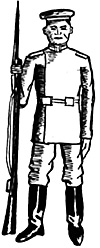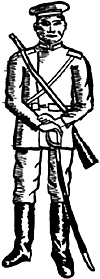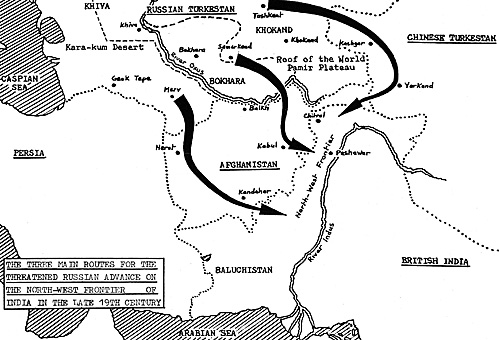
A recent editorial of the Wargamer's Newsletter mentioned that Donald Featherstone was planning a Russian Army of the 1880's who were going to come down through Afghanistan and give a lot of trouble on the North-West Frontier of India. I have just completed a set of rules for wargaming in the Colonial period 1865-1900; in compiling an appendix dealing with the organisation and tactics of the various European armies, I came across several references giving details of the Russian forces in Central Asia in the last quarter of the 19th century and I have collected background information on the most interesting Anglo-Russian confrontation in this area. In fact, the Russians never seriously penetrated the North-West Frontier, although small patrols and agent-provocateurs tried to stir up the Pathans against the British.
Private of the 4th Turkestan Rifle Battalion. Dark green uniform with crimson piping on cap band and collar and crimson shoulder straps.
Nevertheless, the situation was very grave and in 1885 over half the Indian Army was mobilised against the threat of a Russian attack; a mythical campaign involving actions between, for example, the Queen's Own Corps of Guides (Punjab Frontier Force) and the Frontier Troops of Russian Turkestan against a backdrop of snow-covered mountains is quite attractive.
The Russians had been advancing in Central Asia since the mid-18th century. The Kirghiz Steppes had been assimilated into the Russian Empire by a process of establishing lines of military posts along the existing frontier, gradually pushing these forward as circumstances permitted; by introducing Russian officers into the governing assemblies of the tribes; by encouraging the tribesmen to establish villages and become cultivators rather than leading a nomadic life; by taking advantage of any internal dissensions or weaknesses in the tribes; and by supporting the tribesmen against incursions by other invaders. In this way, the Little, Middle and Great Hordes of the Kirghiz Steppes all came under Russian domination.
Next on the list came the Khanates of Khiva and Khokand and the Emirate of Bokhara; these independent states collectively formed the geographical area now known as Turkestan and contained inhabitants from the Uzbeg, Sart, Tadjik, Kirghiz and Turkoman tribes living in cities such as Samarkand, which for ages had been centres for oriental commerce. The Russians first invaded Turkestan in 1864 and by 1871 were in possession of most of Khokand and Bokhara; several pitched battles were fought but the disciplined Russian forces easily defeated the tribesmen.
By 1885, the Russians had reached the Afghan Frontier near Penjdeh and the forces of the Amir of Afghanistan (9000 cavalry, 2000 infantry and 8 guns) were defeated by 4000 Russians with 8 guns. The Afghans were forced to retreat and it was a clear victory for Russian imperialism. When the news reached Britain, the Prime Minister, Gladstone, announced that the attack was unprovoked aggression and Parliament passed a vote of credit of £ 11 million for military preparations against the Russians. The British and Indian forces on the NorthWest Frontier stood to arms.
The routes leading from Russian Turkestan to the North-West Frontier could be divided into three groups (see accompanying map); those running from Tashkent through the Passes of the Tian-shan mountains (Terek Pass 12000 ft) to Kashgar and thence via Yarkand to Chitral and Kashmir (over passes of 14-17800 ft); those leading from Samarkand and Bokhara over the Hindu-Kush Mountains to Kabul and Jellalabad and thence through the Khyber Pass to India; and those which converged on Herat and led via Kandahar to the Bolan Pass and Baluchistan. In addition there was the possibility of an attack from the southern coast of Persia, under Turkish control, but almost incapable of resistance against the Russians because of a recent famine.
The defending forces on the North-West Frontier had to cover all these approaches; lateral communication was very difficult and once assigned to a particular valley, a force would be virtually isolated there. The Russians, of course, had even greater terrain problems to overcome in any invasion, with arid wastes or high passes to cross whichever way they decided to come. An absorbing account of possible routes for the Russian invasion is given in John Masters' novel, "The Lotus and the Wind".
Since uniform and organisational detail is fairly accessible for British and Indian forces of the period, the following description is limited to the Russian forces, mostly those in Turkestan, who would probably be the first Russian troops to come into action.
 Cossack of the 5th Orenburg Regiment. Dark green
uniform with light blue cap band and shoulder straps (Yellow
piping on both).
Cossack of the 5th Orenburg Regiment. Dark green
uniform with light blue cap band and shoulder straps (Yellow
piping on both).
ORGANISATION
In 1890, the Intelligence Division of the War Office published the following details of Russian forces in Turkestan; I assume that the composition was roughly the same five years earlier.
- 1 Brigade of 4 battalions of Turkestan Rifles, each battalion consisting of 21 officers and 960 men on a war footing.
20 Battalions of Turkestan Frontier Troops (numbered 1-20), each battalion consisting of 21 officers and 960 men.
3 Regiments (4th, 5th and 6th) of Orenburg Cossacks, each regiment being composed of 4 squadrons and consisting of 15 officers and 600 men on a war footing.
2 Regiment (2nd) of Ural Cossacks, of 4 squadrons.
2 Squadrons of Astrakhan Cossacks, each squadron consisting of 3 officers and 118 men.
1 Turkestan brigade of 7 artillery batteries, each of 8 Guns.
No. 1 and 2 batteries had heavy field guns (4.2" guns, 6 officers and 236 men). No. 3, 4, 5 and 6 batteries had light field guns (3.42" guns, 6 officers and 204 men per battery). No. 7 battery was a mountain battery (2.5" guns, 6 officers and 233 men).
2 Orenburg horse battery (2nd), with 6 guns of 3.42" calibre, 5 officers and 180 men.
1 Turkestan mountain horse battery with 6 guns of 3.42" calibre, 5 officers and 181 men.
Half-battalion of Turkestan sappers, 14 officers and 480 men, divided into 2 companies.
12 Local infantry detachments, each of 100-300 men.
2 Fortress companies of artillery, 224 men at Samarkand and 224 men at Tashkent.
The total complement in Turkestan was 25,038 infantry, 3,074 cavalry, 2,492 artillerymen, 525 sappers, 2,583 local infantry and 448 local artillerymen (grand total 34,190 men and 68 guns). In any major engagement, troops would probably be fed in from other areas. For example, another field force was based in adjacent Transcaspia and 2 battalions of railway troops, 2 brigades of Transcaspian Rifles, several regiments of Kuban, Taman, and Kavkaz Cossack Cavalry and supporting troops could be sent to Turkestan. From further afield, the East and West Siberian Rifle Battalions could be drafted, and even units of the Guard pressed into service to provide a proportion of high-quality troops.
The military Governor-General of Turkestan also commanded a half-division of boats on the Aral Sea; this flotilla was available for use on the Oxus River to the North of Afghanistan and consisted of 1 launch (2 guns) and 4 steamers (1-5 guns), with an effective strength of 3 officers and 318 men.
Drill
The Russian infantry marched at 116-120 paces per minute in quick time (a pace was 28" so they would cover 90-93 yards per minute; 2 2/3 miles per hour; 13 1/3-16 2/3 miles per 7-9 hour day; and 66 miles per week including 2 rest days). At the double, they covered 210 yards per minute; corresponding British distances were 100 yards per minute in quick time and 151 yards per minute at the double - slow time of 62.5 yards per minute was used only for parade movements or by recruits.
Field artillery travelled 3mph, cav and horse artillery at 3 1/3 mph, trotted at 6 2/3 mph, and trotted and walked 4 2/3 mph, covering 20-26 miles per day (5.5-8 hours). These speeds would be reduced in rough terrain.

Russian Advances Continued [WN120]
Back to Table of Contents -- Wargamer's Newsletter # 119
To Wargamer's Newsletter List of Issues
To MagWeb Master Magazine List
© Copyright 1971 by Donald Featherstone.
This article appears in MagWeb.com (Magazine Web) on the Internet World Wide Web.
Other articles from military history and related magazines are available at http://www.magweb.com